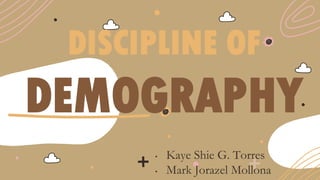
11-MaldivesTORRESandMOLLONAdemography.pdf
- 1. DISCIPLINE OF DEMOGRAPHY • Kaye Shie G. Torres • Mark Jorazel Mollona
- 2. OBJECTIVES: AT THE END OF THIS MODULE, I CAN: 1. Connect the discipline of Demography with its Historical and Social foundation. 2. Trace the historical foundation and social context that lead to the development of demography as a social science discipline. 3. Compare and contrast social science discipline according to their fields, main area of inquiry, and methods. 4. Determine how demography can be used to address social concerns.
- 3. 03 01 02 04 TABLE OF CONTENTS DEVEOPMENT OF DEMOGRAPHY CLASSICAL WORKS CURRENT APPLICATION FIELDS OF DEMOGRAPHY
- 4. DEMOGRAPHY Demography comes from the Greek words demos (people) and graphia (a description of). • From this Ethymology, we may derive that demography is the study of human populations through the use of statistical analysis and mathematical modeling. • A population’s basic features include age, sex, family, and household status. • The socioeconomic features of a population are religion, language, ethnicity, education, income, and wealth.
- 6. Englishman John Graunt (1620-1674) 01 His book Natural and Political Observation Made upon the Bills of Morality (1662). • Described the weekly deaths and baptism that went back to the end of the 16th century.
- 7. JOHAN SUSSMILCH (1717-1767) 02 His book THE DIVINE ORDER (1741) • Provided the mortality tables for the entire populations of Prussia. • A german demographer, pastor, and statistican. • Considered as a pioneer in demography and one of the Founding Father of German demography.
- 8. 18TH CENTURY • The increased awareness and significance brought by mortality tables and death rates help establishing life insurance industries. • Later on, civil registries recorded births, deaths, and marriages which further developed to offset church registries. 18TH CENTURY 19TH CENTURY • The study of demography continued to focus on mortality, considerable attention was given in the second half of the 19th century when a downward trend in fertility rates was noticed
- 10. THOMAS MALTHUS ● An English Cleric Scholar whose most notable work is “An Essay on the Principle of Population (1798). ● He discussed how population growth would inevitably lead to increase in consumption of products required for human living. ● This theory, which describe and predicts that the rising trend in population growth would lead to widespread poverty, is now called Iron Law of Population.
- 11. KINGSLEY DAVIS (1908-1997) ● American sociologist and demographer whose works produced theories about society and populations. ● His most important works, The Population of India and Pakistan (1951)and World Urbanization(1972). ● He is known to have coined and defined the term Zero Population Growth, which refers to a phenomenon when the birth rate of the population is equal to its death rate.
- 12. TIMOTHY DYSON ● DEMOGRAPHIC TRANSITION refers to the movement of populations from high and roughly equal death and birth rates, to low and roughly equal death and birth rates. ● He is an retired professor of population studies at the London School of Economics, provided two instances of demographic transition between pre-transition and post- transition.
- 13. TRANSITION PERIODS PRE-TRANSITION ● Occurs when birth and death rates are high infants seldom reach their first birthdays. POST-TRANSITION • Is characterized by high live birth rates and low death rates due to advancements in medicine and technology.
- 15. TWO TYPES OF DEMOGRAPHY Is a quantitativre study of population in the past.Historical demographers use, among others, censuses conducted by governments, historical records, church registries, genalogies and family trees to establish an approximation of demographic data. Historical Demography Social Demography Uses demographic data to describe and explain social phenomena. It investigates social phenomena that affects the distribution, growth, migration, and settlement of populations. Social demography also studies the social status distribution within a population.
- 17. FERTILITY ● Can either mean the live birth of a population or the number of women in childbearing age(15-49 years old). A society with a high fertility rate could have an expected increase in population
- 18. MORTALITY ● Is the death rate or frequency of death in a population. A low mortality rate could contribute to an increase in population but could also affect social dynamics due to issues relating to an aging population. If people live longer, they create a bulge in the aging population which in turn shifts the needs of society.
- 19. MIGRATION -Is the movement of people across a particular boundary to establish a permanent or semi-permanent residence. INTERNATIONAL INTERNAL • Refers to the movement of people within the boundaries of a country • Refers to the movement of individuals from one country to another
- 20. URBANIZATION POPULATION • Refers to the number of inhabitants in a given area such as countries and regions. • Refers to the growth percentage of the urban population to total population
- 21. RESEARCH METHOD IN DEMOGRAPHY DIRECT INDIRECT • One technique used by contemporary demographer is “Sister Method”. • Another technique is interviewing people and questioning them about their families. • First method is gathering data through registries • Second method is acquiring data through censuses conducted by national governments
- 22. CURRENT APPLICATION OF DEMOGRAPHY BIODEMOGRAPHY POPULATION GEOGRAPHY • Population demography is the scientific study of people and their distribution over regions and through time. • Is the integration of biological theories with the study of demography.
- 23. THANK YOU!